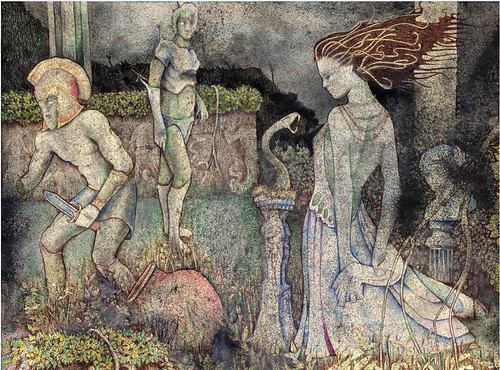
Rationalizing Clerics has troubled me since starting Valley of Blue Snails, and I have thus far avoided the issue by skirting over all but the most basic details. Naturally this has to end as I am sewing up some loose ends as I am putting together a working copy of the rules and setting. I have about a month left however, which is enough time for some new ideas.
One idea I have been messing with is using a pantheon war between four or five pantheons. The pantheons would likely be fairly straight forward with vastly different agendas and philosophies. Naturally they come into conflict with one another and use their mortal power-base to wipe each other out. So which pantheons? I am not sure yet, but I need something that would have constant conflict within civilization. My first inclinations (and cheesy names off the top of my head):
Fiorse (Finnic/Norse) - Finnic and Norse have similar themes, stories and philosophies. A lot of the gods themselves are practically interchangeable. Hierarchical but independently motivated with vying agendas. Generally have the best interest of themselves and the world at heart.
Egyines - (Egyptian/Chinese) - Foreign pantheon encroaching on the civilized areas of the campaign. Thus while they are definitely human/humanoid, they have very different and alien philosophies. Similar to above with a hierarchical map of gods, although their vision of good/evil and right and wrong are vastly different.
Paragons - Each race has a paragon deity(or deities) which embodies the archetype of that race. They will have their own pantheon and it will include everything from humans to elves to fey to dragons to were-elephants. The deities are equally powerful and quite potent. They however rarely work together and only have the best interest of their patron race to care for.
Nehmerian - (Nehwon/Cimmerian) - These gods are identifiable as human or humanoid but usually more eccentric and defiantly more rogue. They have no organization and battle with each other as often as other pantheons. This is the largest 'pantheon', at least by sheer numbers of deities. This is the home of the 'failed' Paragons as well.
'Old Gods' - This will blanket anything that is not above including primeval deities, deities from long ago, elemental or natural force deities, loathsome unfathomable deities, and just about anything else that does not fit in.
The most important thing is that they fight with one another considerably. And so a good reasons for mace wielding, spell casting, holy warriors to be around. They would naturally vie with other pantheons foremost, and with each other secondarily. Temples would be erected either towards an entire pantheon or specific deities. Specific deities mostly, although other deities of the same pantheon could certainly be worshiped there, at least if the first few examples above.
Deities that are clearly historical will use a thinly veiled disguises with a name change and perhaps some small changed to fit the setting. Most of the others I will make up on the fly. Individual Clerics would support a specific deity first, and pantheon secondarily. They would fully be expected to battle on the front lines using martial skills in combination with divine magics.
The gods themselves are strictly tied to their nature and simply do not know how to behave otherwise. This makes them have little reason to interfere directly with mortals, unless it is simply to fuck with them. Most mortals are far too unpredictable for gods, sort of like a shovel with a hose for a handle. Gods will usually only speak to the most obedient and best trained priests who act as close to them as they possible - and so these priest end up being the most powerful. The gods are also not omnipotent; they may have prophecies to share but can not tell for sure what the future will hold. Gods frequently make mistakes when they delve into things that are not in their nature - and so most gods loath to do so. Gods can understand what all mortals say but can not listen to their minds. Lastly gods can and do die.
Anyhow, some of this will likely change as I mull it over. Perhaps drastically if I come up with something better.

When a Goddess dies, is there a void that must be filled or is it purely the next God is made when someone is up to snuff?
ReplyDeleteThere is no god-threshold, but rather an ebb and flow of new divinity and others dying from one cause or another. The 'Old Gods' are indeed very old, unfathomably older than the other pantheons and are ultimately the survivors.
ReplyDelete
ReplyDeletesvenska online casinon
poker online sverige
thrills casino sverige
thrills casino